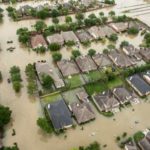As I write this, the city of Houston, and for that matter most of south east Texas, is getting hammered by tropical storm Harvey. Thousands of people have lost their homes to flooding, which is a terrible tragedy. Mind you, this is not a new thing. Floods have been hitting this region of years. There are reasons why Harvey could be seen as especially bad, but flooding is a way of life for some parts of the world, and it will always remain so.
Rather than talk about the tragedy of flooding, or attempt to point my finger in an area I know little about and understand even less, what I want to do here is offer a view towards a new and different future. A future in which I think has room for everyone, regardless of where you live, or the color of your political stripe.
One of the things we learned from hurricane Katrina, and we will learn from Harvey, is that flooding a house is expensive, Once water has reached the walls of a house, the cost of rebuilding it is staggering. Water is absorbed by almost all modern building materials, and once that material has been saturated it will either warp, become susceptible to mold, rot, fall apart, or do a variation on all four. On many houses, once it has been dipped in water, the costs associated with repair are so high that is it cheaper to simply tear down the home and start from scratch.
Now I’m not talking about shacks here, but houses. Homes that were, until the moment the river got a little too high, worth an appreciable amount of the owners net value. Literally, it’s like taking out $100,000 in bills from the bank, and tossing them in the river. Only multiplied by thousands and thousands of homes. The cost alone for replacement is enough to bankrupt most countries, and this from just one part of Texas. And this is not even taking into account the personal tragedy of people losing their property, mementos, and sadly their lives.
But what of there was a different path? What else can we do?
The single largest problem I see is that these houses were not built to be submerged. I’m not talking about the ability to face storm surges like what ripped out a lot of homes on the gulf coast from Katrina, but just being dunked for a few days in water. As long as the current forces aren’t all that high, and in a lot of flat areas that is all the kind of flooding most will see, a house that can withstand 4-6 feet of water, for 2-3 days, and can be livable again with just a few hours of repair, would be a huge cost saver for the state. Sure some of the items in such a house might be damaged, but replacing them is a small cost compared to loosing everything, and with a little planing could be easily remedied. For instance, if every room had special floats designed to hold furniture and equipment, one could inflate them, load them up with valuables, and let them ride out the storm high and dry.
Now this is not a new idea, flood proof homes have been designed and built for millennia. Do a google search for “flood proof houses” or see here, or here. What’s needed is not knowledge, but political will. What if the state of Texas offered a premium on houses rebuilt with flood proof materials or techniques? What if flood proof houses received a huge break on flood insurance? These are just a couple of ways to link the free market to less government costs.
Another idea would be to offer an X prize for flood proof houses, with the winner awarded a contract to rebuild homes in certain flood prone areas. Model homes could be built and tested, with all the data available to the public. People could see what works and what doesn’t, and the total costs would be pennies when compared to what we’ll be spending the next time this disaster happens. Because believe me, we’ll be seeing flooding in America again. There’s a long history of it.
Right now as I write this members of Congress are talking about passing a multi-billion dollar relief package for those effected by Harvey, so we’re sure to see a lot of money spent. Why not take the time and learn from our mistakes? Some places in Texas are going to flood, and there’s not much you can do about that, short of spending billions of dollars in large scale drainage systems, which themselves are likely to fail. Why not instead build houses with nature in mind? House that can be dunked, and then used over again without damage, mold, or loss. Why not spend a little now to ensure later success? That would not only be financially wise, but would also save lives. And isn’t that what our country should be about.
Lets be smart people. Lets spend our money well.

